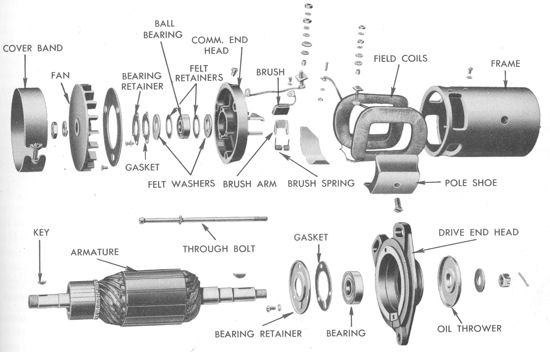
Home | Site
Map | Contact Information

| An Auto-lite
generator will have a tag with the generator
number stamped on it, hopefully the tag is still in place. The
terminals are labeled in the illustration. The armature terminal (also
referred to as the generator terminal) is a larger
diameter than the field terminal since more current flows in that
circuit. The ground screw is simply threaded into the generator frame. The voltage regulator must be matched to the generator, see chart below for the proper regulator number. CJ-3As used Type A generators, other Willys Jeeps did use Type B. If the Type is unknown skip down to Determining the Generator Type. |
 |

| First set the multi-meter to the
low ohms range. Connect one lead to the field terminal (small diameter)
and then measure the resistance to the armature terminal (large
diameter) with the other lead. See the photo to the right. A normal
reading is less than 10 ohms, here it is 3.7 ohms. |
|
| Now move the lead from the
Armature terminal to the Ground screw. Again the normal reading of less
than 10 ohms is seen in the photo. If the resistance of these two
checks is not less than 10 ohms each there is an internal problem with
the generator that must be repaired first. |
| To isolate the armature for this test remove the brush cover band. Lift one of the brushes and slip a cardboard strip between the brush and the commutator. It does not matter which brush is insulated since either will break the armature circuit continuity. In the photo the generator housing, or frame, has been removed for clarity. The cardboard strip can be inserted through the brush access holes without generator disassembly. |
| With the armature out of the
circuit repeat the first two tests. Check the resistance from the field
terminal to the armature terminal. For a Type A generator this
measurement will remain unchanged (less than 10 ohms) as seen in the
photo. This is because internally the field is connected to the
armature terminal. If this was a Type B generator the reading would be
an open
circuit, or no continuity. |
|
| Now move the test lead to the
ground screw. For a Type A generator this is now an open circuit, or no
continuity, as seen on the multi-meter. If this was a Type B generator
this reading would be less than 10 ohms because internally the field is
connected to ground. |
CJ-3A
Auto-lite
Generator Component Part numbers and
Specifications
| GDZ-48l7A | GDZ-600lD | GGW-4801D | |
| Armature | GDZ-2006F | GGY-2006F | GGW-2006F |
| Brush Set | GGU-2012S | GGY-2012S | GGY-2012BS |
| Commutator End Head Assembly |
GDZ-2087A | GGW-2002S | GGW-2002S |
| Commutator End Bearing | GBF-79 | GGU-38A | GGU-38A |
| Brush Arm (2 used) |
GCJ-26 | GCJ-26 | GCJ-26 |
| Brush Spring (2 used) | GBW-45 | GGY-45 | GGY-45 |
| Field Coil Assembly |
GDZ-1005 | GGW-1005 | GGW-1005 |
| Drive End Head Assy. | GDZ-1088A | GGW-1003 | GGW-1003 |
| Drive End Bearing |
X-295 | X-295 | X-295 |
| Pulley or Fan | SP-1885 | SP-1986 | SP-1986 |
| Voltage Regulator | VRP-6003A | VRP-6003A | VBE-6105A |
| Generator
Specifications |
|||
| Rated Volts |
6V | 6V | 6V |
| Rotation at the drive end |
Clockwise | Clockwise | Clockwise |
| Brush Spring Tension |
35-53oz. | 35-53oz. | 35-53oz. |
| Field Coil Draw |
5.0V, 1.3-1.5A | 5.0V, 1.3-1.5A | 5.0V, 1.4-1.5A |
| Motoring Draw |
5.0V, 3.9-4.4A | 5.0V, 3.9-4.4A | 5.0V, 4.1-4.6A |
| Output |
8.0V, 35.0A max, 2000 rpm max | 8.0V, 35.0A max, 2000 rpm max | 8.0V, 45.0A max,
2125 rpm max |
The CJ-3A Story | CJ-3A
Photos | CJ-3A Specs and Tech Tips | CJ-3A Literature | Siblings of the CJ-3A | Accessories | Links
3/07
www.cj3a.info © 2007